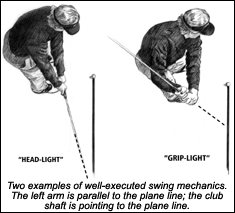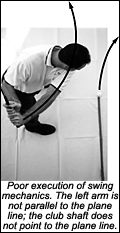Dear Dr.
Your patient has pain in the right wrist because he allows the incline plane of his club shaft to collapse (or flatten out) during the downswing. When this occurs, the energy of the downswing "jumps the track" and heads to the right of his intended target. In an attempt to recover, your patient flips his right wrist into extreme hyperflexion just after impact with the ball, to redirect the flight path of the ball back to the target. This is not a conscious effort, but a reflex reaction, as the mind's eye remembers the location of the intended target.
Let me explain with pictures:
When the left arm swings parallel to the plane line behind the ball, the energy of the body releases "on track" toward the intended target. When the club shaft points to the plane line behind the ball, the energy of the club head releases on track toward the intended target. The result is essentially no strain on the muscles, ligaments, tendons or joints surrounding the right wrist.
When the left arm pulls inside the plane line during the backswing, it must push toward the plane line on the downswing. In other words, your patient is pushing the energy of his or her body to the right of the intended target during the downswing. To redirect the energy back toward the target, your patient needs to flip the wrists into hyper-flexion during impact with the ball. If the wrist flip occurs quickly, the ball will go dead left of the target; if the wrist flip is too slow, the club face will cut across the face of the ball and slice it out to the right. In either scenario, the mechanical strain on the muscles, ligaments, tendons and joints surrounding the wrist is extreme and will lead to chronic inflammation.
Correction Protocol
Have your patient place a strip of tape under the ball extending to 10 feet behind the ball. Direct him or her to place a swing trainer on the grip of the club. A swing trainer will visually extend the club shaft with beams of light, to ensure it is "on plane" throughout the swing.
Ask your patient to rehearse swinging the left arm parallel to the plane line to release the body's energy toward the intended target. The patient should always keep the trainer in contact with the plane line, so the club shaft does not drift "off plane." This is neuromuscular re-education, designed to eliminate the root cause of a repetitive mechanical strain syndrome. Your patient should rehearse this "safe swing" 50 times a day. Remember, different clubs are of different lengths. Recommend that the patient change clubs frequently to practice adjusting to the different incline planes.
Jeffry Blanchard, DC
Encinitas, California
Dr. Jeff Blanchard is a practicing chiropractor who competes as a golf professional. He is the author of The PGA Professionals' Golf Injury Desk Reference (2007). For questions or comments regarding this article, contact Dr. Blanchard at 805-772-8298 or .






